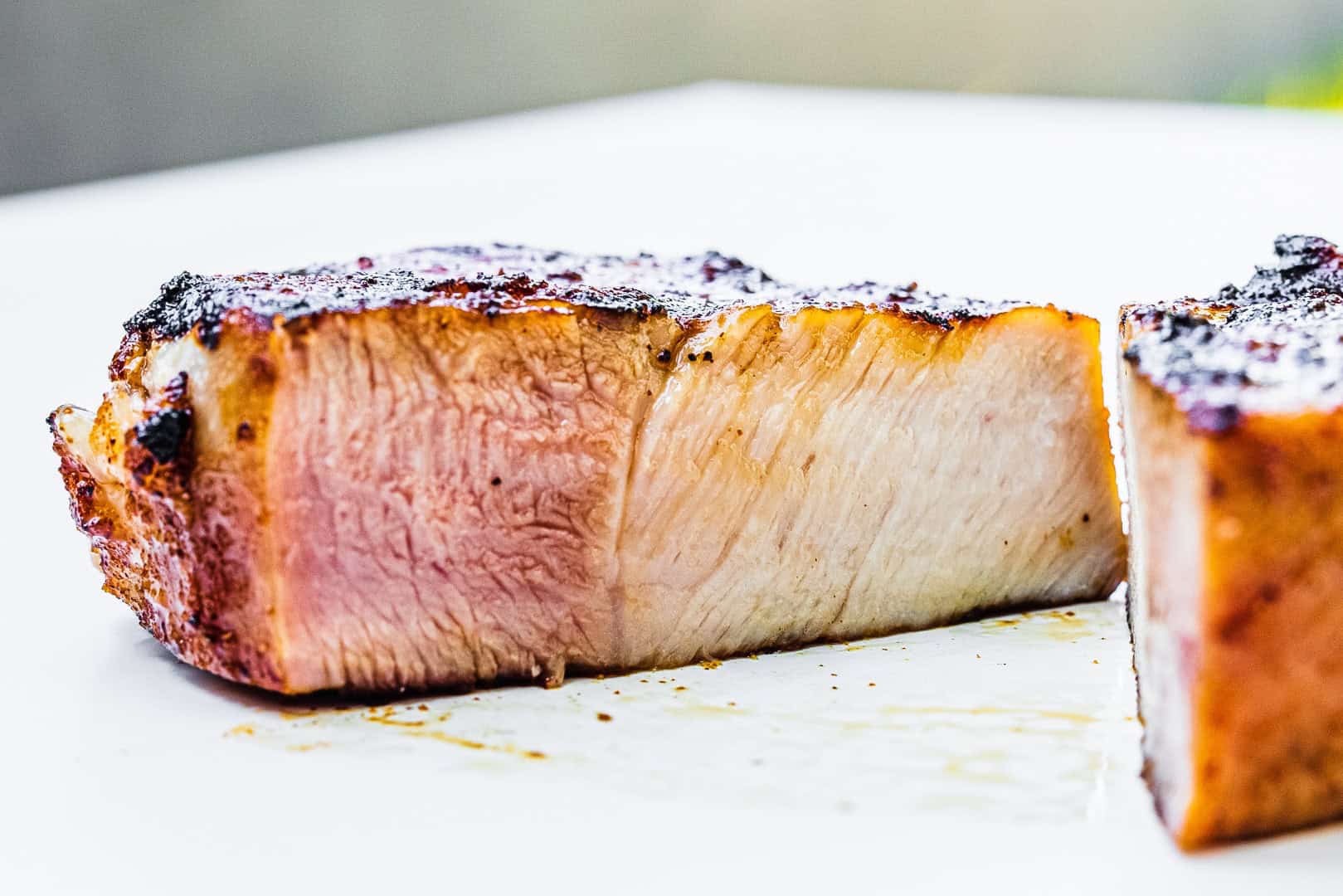Are you one of those people who anxiously poke and prod their pork, trying to figure out if it’s cooked just right?
Well, worry no more!
In this short guide, we will reveal the telltale signs that indicate whether your succulent pork is safe to devour or if it needs a little more time in the oven.
Get ready to unlock the secrets of perfectly cooked pork that will leave your taste buds dancing with joy!
how to tell if pork is cooked
To determine if pork is cooked, it is essential to check its internal temperature with a meat thermometer.
The safe internal cooking temperature for fresh cuts of pork is 145°F (63°C).
Ground pork should be cooked until it reaches 160°F (71°C).
Fully cooked ham can be reheated to 140°F (60°C) or enjoyed cold.
For fresh ham, cook until the temperature reaches 145°F (63°C) and let it rest for 3 minutes before serving.
Remember, using a meat thermometer is the most reliable method to ensure pork is cooked thoroughly.
Key Points:
- Check the internal temperature of pork with a meat thermometer to determine if it is cooked.
- Fresh cuts of pork should reach an internal temperature of 145°F (63°C) to be safe to eat.
- Ground pork should be cooked to an internal temperature of 160°F (71°C).
- Fully cooked ham can be reheated to 140°F (60°C) or eaten cold.
- Fresh ham should be cooked to an internal temperature of 145°F (63°C) and allowed to rest for 3 minutes before serving.
- Use a meat thermometer for the most reliable method of ensuring pork is cooked thoroughly.
how to tell if pork is cooked – Watch Video
💡
Pro Tips:
1. Contrary to popular belief, the color of pork is not a reliable indicator of its doneness. Instead, opt for checking the internal temperature with a food thermometer, ensuring it reaches 145°F (63°C) for safe consumption.
2. To inspect the doneness of pork without cutting into it, pierce the thickest part of the meat with a fork or skewer. If the juices run clear or pale yellow and not pink, it is likely cooked.
3. Did you know that resting pork after cooking is crucial? Allowing cooked pork to rest for at least 3 minutes before cutting into it helps retain its juiciness and texture.
4. One lesser-known technique to determine if pork is fully cooked is the “fork twisting” method. Insert a fork into the meat, twist, and then remove. If it easily comes out without any resistance or excessive amount of pink juices, the pork is most likely done.
5. In some cultures, a traditional way to ensure pork is cooked is by using the “chopstick test.” Insert a chopstick into the thickest part of the meat and hold it there for a few seconds. Then touch the tip of the chopstick to your lower lip; if it feels hot to the touch, the pork is cooked through.
Safe Internal Pork Cooking Temperature For Fresh Cuts: 145° F
When it comes to cooking pork, ensuring that it is safely cooked is of utmost importance. The safe internal pork cooking temperature for fresh cuts is 145°F. This means that the pork should reach this temperature in order to kill any potential bacteria and ensure that it is safe to consume.
To determine if pork is cooked to the proper temperature, it is essential to use a food thermometer. This handy kitchen tool will accurately measure the internal temperature of the meat. Insert the thermometer into the thickest part of the pork, avoiding any bones or fatty areas. Once the thermometer reads 145°F, you can be confident that the pork is safely cooked and ready to enjoy.
It is important to note that after reaching the safe internal temperature, it is recommended to let the pork rest for a few minutes before slicing or serving. This allows the juices to redistribute within the meat, resulting in a more flavorful and tender final product. So, remember to account for the resting time in your cooking process.
Ground Pork: Cook To 160° F
Ground pork requires a slightly higher cooking temperature to ensure safety. The internal temperature for ground pork should reach 160° F. This higher temperature is needed because ground meat has a higher risk of bacterial contamination due to its increased surface area for bacteria to thrive.
When cooking ground pork, it is essential to use a food thermometer to accurately measure the internal temperature. Similar to fresh cuts, insert the thermometer into the thickest part of the meat, away from any bones or fatty areas. Once it reaches 160° F, you can be confident that the ground pork is thoroughly cooked and safe to consume.
Remember, never rely solely on visual cues such as color or texture to determine if ground pork is cooked. Safely cooked ground pork should reach the recommended internal temperature to ensure that any harmful bacteria are eliminated.
- Use a food thermometer to measure the internal temperature.
- Insert the thermometer into the thickest part of the meat.
- Cook ground pork until it reaches 160° F internal temperature.
“Never rely on visual cues such as color or texture.”
Reheating Fully Cooked Ham: 140° F Or Cold Enjoyment
Reheating fully cooked ham is a common practice, especially during special occasions or holiday meals. The optimal temperature for reheating cooked ham is 140° F. However, it is worth mentioning that fully cooked ham can also be safely enjoyed cold if desired.
To reheat fully cooked ham, follow these steps:
- Preheat your oven to 325° F.
- Place the ham in a baking dish or roasting pan and cover it loosely with aluminum foil. This will help retain moisture and prevent the ham from drying out during the reheating process.
- While the oven is preheating, use a food thermometer to monitor the internal temperature of the ham.
- Once the internal temperature reaches 140° F, which may take about 10-15 minutes per pound, the ham is ready to be served.
- Remember to let the ham rest for a few minutes before slicing and serving.
Alternatively, if you prefer to enjoy the ham cold, it can be sliced and served directly from the refrigerator. Cold ham can be a delightful addition to charcuterie boards, salads, and sandwiches. Just make sure to store any leftover ham properly in the refrigerator to maintain food safety.
Note: Reaching an internal temperature of 140° F when reheating fully cooked ham is crucial to guarantee its safety.
Whether hot or cold, properly cooked ham will be a delicious addition to your meal.
- Reheating should be done at 325° F.
- Cover the ham loosely with aluminum foil.
- Use a food thermometer to monitor internal temperature.
- Let the ham rest for a few minutes before slicing and serving.
- Enjoy leftover ham cold in charcuterie, salads, and sandwiches.
💡
You may need to know these questions about how to tell if pork is cooked
How do you know if pork is undercooked?
To ensure that pork is cooked thoroughly, it is important to monitor the internal temperature using a meat thermometer. The recommended temperature for cooked pork is 145°F (63°C). By inserting the thermometer into the thickest part of the meat, you can easily determine if it has reached the proper doneness. Once the pork reaches the recommended temperature, it is safe to enjoy without any concerns of undercooking.
What color is pork when fully cooked?
Color-wise, when pork is fully cooked it transforms into a delicate pale hue, adorned with shades of white and gray. This transformation occurs when the pork reaches an internal temperature of 160 degrees. However, when cooked to a slightly lower temperature of 145 degrees, the pork retains a distinctive pinkish shade, creating a visually striking contrast.
Is pork done if a little pink?
When it comes to pork, don’t judge doneness solely based on color. Although a little pink in the center may seem alarming, it doesn’t necessarily mean it’s undercooked or unsafe to consume. Pork can still be considered safe if it has reached a minimum internal temperature of 145°F (62.8 °C) throughout, even if it retains a pinkish hue. Remember to use a food thermometer to ensure proper cooking temperature and enjoy your delicious pork without worry.
What does pork look like when its done cooking?
When pork is cooked thoroughly, it typically has a slightly pink color in the center, which is completely normal. This allows for a juicy and tender texture, while still ensuring that the meat is safely cooked. Whether you prefer your pork well-done or slightly pink in the center, rest assured that it can be cooked to perfection and enjoyed in a variety of ways.
Reference source
https://www.pork.org/pork-cooking-temperature/
https://simplyhatfield.com/overcooking-vs-undercooking-how-to-tell-when-pork-is-ready/
https://www.kitchenparade.com/2013/09/should-cooked-pork-be-pink-yes-and-no.html
https://ask.usda.gov/s/article/Is-pink-pork-safe



